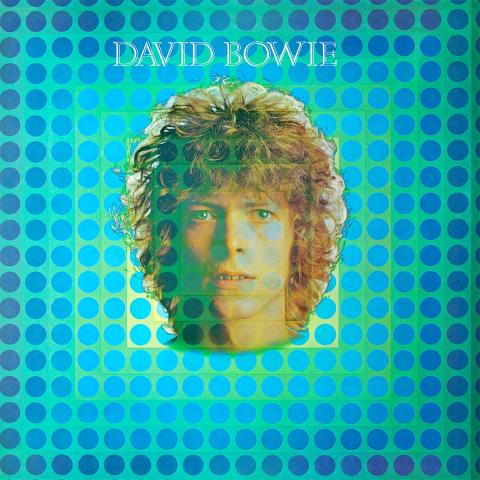Today marks the 50th anniversary of the first moon landing in human history. Five days prior to the launch of NASA’s Apollo 11 mission, David Bowie, a British folk singer who later became one of the most legendary music icons of all time, released the seven-inch single Space Oddity, a song that both echoed and ran contrary to the “space fever” at the time, and in which Bowie’s quasi-autobiographical character “Major Tom” made his first appearance.
Conceived after watching Stanley Kubrick’s 1968 film 2001: A Space Odyssey, the song bears an apparent allusion to the epic sci-fi classic, not only in its title but also at the beginning of the song. A barely audible deep bass tone echoes the first few bars of Richard Strauss’ tone poem, named after Friedrich Nietzsche’s philosophical novel of the same title Also sprach Zarathustra, which features prominently in the film’s majestic opening sequence.
Throughout his life, Bowie never denied the connection between his Space Oddity and Kubrick’s 2001: A Space Odyssey. In the movie, space voyagers — or call them astronauts, if you want — are threatened and betrayed by their spaceship’s computer “HAL,” which was built with a human personality that turns from being an amiable companion to a gruesome killer. “I related to the sense of isolation,” Bowie said of the movie, and this sense of isolation eventually became the backbone of his song.

Photo: Wikimedia Commons
照片:維基共享資源
Another possible origin of inspiration was the less celebrated BBC-TV drama titled Beach Head, as the episode “Out of the Unknown” was aired on January 28, 1969, which precisely corresponds with the gestation period of Space Oddity. The episode offered a bleak portrayal of a space pilot, Commandant Tom Decker, landing on Planet 0243/B with his spaceship, but the plot showed not so much the extraterrestrial world as the protagonist’s ennui, which anticipates the alienation that haunts Bowie’s Major Tom.
The rush of recording Space Oddity and the release date hints at the record label’s attempt to capitalize on the Apollo craze, as evidenced by Tony Visconti, who later became Bowie’s regular and longtime producer, regarding it as a “cheap shot” at the impending space mission. Bowie himself was rather ambivalent: on one occasion, he was reported as saying “I want it to be the first anthem of the Moon” and “play it as they hoist the flag,” while saying “I suppose it’s an antidote to space fever, really.” On another occasion, Bowie said dismissively of Space Oddity that “It’s only a pop song, after all.”
An antidote to the space fever, indeed. While Space Oddity was miraculously chosen by the BBC to be broadcast during its Apollo coverage, the chilling conclusion of the song and the bleak portrayal of life in space almost went unnoticed. As “the papers want to know whose shirts you wear,” life in space was just as hollow as it was on Earth. Bowie’s musical partners further intensified the single’s eerie atmosphere: John Hutchinson’s design of a floating F major 7 chord that opens the song effectively portrays the astronaut’s state of being adrift in space; while Paul Buckmaster’s string arrangement casts an unsettling shadow that fittingly evokes the unnerving modernist music written in fin-de-siecle Vienna. Bowie’s use of a Stylophone, a miniature analog stylus-operated keyboard, adds a futuristic touch to the song.
Major Tom made a few reappearances throughout David Bowie’s career: in the 1980 art rock single Ashes to Ashes, he was “a guy that’s been in such an early song,” who, according to “a rumor from Ground Control,” turned into a junkie “strung out in heaven’s high.” Near the end of the music video for the song Slow Burn on Bowie’s 2002 album Heathen, an astronaut standing with both hands in his pockets appears in the studio with Bowie himself, in a manner much like his other persona. The skull of a dead astronaut, possibly Major Tom’s, is depicted in the music video of Bowie’s 2015 song Blackstar on the album of the same name. As the album was released in 2016 two days prior to the artist’s death according to a plan painstakingly designed by Bowie himself, and the skull in the video was eventually retrieved as a relic for cult worship, the skull, which foreshadows Major Tom’s final fate, becomes an obvious reference typical of Bowie’s clever tricks of self-allusion. Three years after Bowie’s passing, one wonders how Major Tom is doing beyond our earthly world.
(Chang Ho-ming, Taipei Times)
今天是人類歷史上第一次登陸月球的五十週年。就在美國太空總署展開阿波羅十一號登月任務的五天前,當時仍是一位英國民謠歌手,後來成為傳奇搖滾巨星的大衛‧鮑伊,發行了七吋黑膠單曲《太空怪談》。這首歌曲既呼應著瀰漫當時社會的「太空熱」,同時卻又向這股狂熱背道而馳。鮑伊半自傳式的虛構角色「湯姆少校」也在這張單曲中初次登場。
這首歌的創作靈感來自一九六八年史丹利‧庫伯力克執導的電影《二○○一太空漫遊》,不僅以歌名明顯呼應庫伯力克的史詩科幻經典,歌曲開頭幾乎聽不清楚的極低音聲響,則是向電影開頭的壯闊音樂致敬,那段音樂來自作曲家理查‧史特勞斯,閱讀弗里德里希·尼采的同名哲學小說後,譜下的交響詩《查拉圖斯特拉如是說》。
鮑伊畢生從未否認過他的歌曲《太空怪談》跟庫伯力克的電影《二○○一太空漫遊》之間的關聯。在電影中,穿梭太空的旅人(你喜歡的話,也可以說他們是太空人)遭到太空船上的電腦「HAL」恐嚇並背叛。這台電腦內建人類般的性格,從一開始的和藹可親逐漸變成心狠手辣。鮑伊提到這部電影時,曾說:「我對那種孤立感亦感同身受。」這樣的孤立感最終成為歌曲基調。
另一個可能的靈感來源較不為人熟知,是英國廣播公司製作的電視影集《Beach Head》,其中一集標題為「來自未知」,播出於一九六九年一月二十八日,正好是鮑伊構思創作這首歌的期間。該集描繪一名太空飛行員──指揮官「湯姆」‧戴克──隨太空船降落在編號0243/B的荒涼行星上,只不過整集情節並沒有在外星世界著墨太多,反而呈現主角對世間產生的強烈倦怠感,預示鮑伊筆下「湯姆少校」內心縈繞的疏離感。
《太空怪談》匆促的錄音和發行日期,在在暗示唱片公司企圖搶佔大眾瘋迷「阿波羅登月」商機,這可見於鮑伊日後長期合作的製作人托尼‧維斯康堤,當時他認為這首歌曲搶在太空任務前幾天發行,是個「廉價的行銷手段」。鮑伊本人看法則是相當模稜兩可:在一次訪談中,據聞他說:「我要讓這首歌成為月球的第一首國歌」,而且還要「在太空人立旗的時候播放」,同時卻說「我想這首歌應該是太空熱的解毒劑,我真的這麼想。」在另一個場合,鮑伊卻對《太空怪談》輕蔑地表示:「畢竟,那不過就是首流行歌。」
這首歌確實可說是當年太空熱的解毒劑。儘管《太空怪談》奇蹟似地被英國廣播公司選在阿波羅登月任務報導時播放,這首歌曲令人寒心的結尾以及對太空生活的蒼白刻畫在當時卻幾乎沒有人注意到。正如同歌詞寫道,「報社記者想知道你穿什麼牌子的襯衫」,太空生活就跟地球上的生活一樣空洞無比。另一方面,鮑伊的音樂夥伴們展現出不同才華,更加強化這首單曲的詭異氛圍:約翰‧哈欽森為這首歌曲的開頭,設計出一個充滿漂浮感的F大七和弦,有效地描繪出太空人漫無目標地在太空中漂浮的情境;而保羅‧巴克馬斯特的弦樂編曲則投射一抹不安的陰影,相當適切地召喚出十九世紀末維也納那種讓人心神不寧的現代主義音樂風格。鮑伊使用的「筆型合成器」,也就是一種迷你版的類比筆尖觸控式鍵盤樂器,則為歌曲加入些許未來主義式的氣息。
「湯姆少校」數度在鮑伊的音樂生涯中再現:在一九八○年的藝術搖滾金曲《Ashes to Ashes》中,「湯姆少校」是「那首好久以前歌曲裡面的那個傢伙」,現在據「地面控制中心傳出的謠言」指出,已經變成一個「神智恍惚、飄飄欲仙的毒蟲」。二○○二年專輯《異教徒》收錄歌曲《Slow Burn》的音樂影片在接近結尾時,也出現一名雙手插在口袋的太空人,站在錄音室裡的鮑伊身旁,就好似他的另一個人格。在二○一五年披露的歌曲《Blackstar》音樂影片中,則出現一個死亡太空人的頭顱,很可能就是「湯姆少校」的頭骨。在鮑伊的精心策劃下,這張專輯在二○一六年他過世的前兩天發行,而影片中的頭骨既預示「湯姆少校」最後的命運,被人尋回後又成為異端宗教膜拜的聖物,很明顯地就是典型的大衛鮑伊,在作品中巧妙地玩弄自我指涉。在鮑伊離世三年後,大家都想知道,不知道「湯姆少校」在塵世之外過得好不好。
(台北時報章厚明撰)

Bilingual Story is a fictionalized account. 雙語故事部分內容純屬虛構。 I stand by the Miluo River as dusk falls. The court betrayal is too much. I served Chu with loyalty. I forged alliances and fought corruption. But the whispers of jealous courtiers, the murmurs of treason, spoke louder. The king cast me out. The water looks calm. It promises peace. I step in. The river is cold against my legs. I hear shouts behind me — fishermen calling my name. I keep walking. The calls grow louder, but I do not turn around. The water rises to my chest. It pulls at me. I

In Taiwan, people can use a platform to rent a power washer for a weekend or share unused garage space for someone’s storage needs. These are examples of the sharing economy, a consumption model that has gained widespread adoption worldwide. This approach allows people to rent or share assets like cars, homes or even services, typically through online platforms. This innovative model poses a simple yet powerful question: why purchase infrequently used items when sharing is more practical? By making useful but idle resources accessible, the sharing economy turns them into sustainable opportunities. Internationally, platforms like Airbnb and Uber have popularized

A: Recently, I’ve been seeing mosquitoes flying around in front of my eyes. The doctor said it’s the “flying-mosquito disease.” B: Flying mosquitoes? What a strange name. A: They’re actually called “floaters” in English, meaning floating debris. When fibrous substances in the vitreous body inside the eyeballs increase, floaters can appear in the visual field. B: Oh my goodness. Can you get rid of them? A: According to ophthalmologist Horng Chi-ting’s research, taking the enzymes of certain fruits is likely to help reduce floaters. A: 我最近一直覺得眼前有蚊子飛來飛去,結果醫生說是「飛蚊症」。 B: 飛蚊症?好奇怪的病名。 A: 英文名稱叫「floaters」, 也就是漂浮物的意思。 因為眼球的玻璃體中纖維化物質增多,導致視野出現漂浮物。 B: 天啊!要怎麼把蚊子趕走? A:

Continued from yesterday(延續自昨日) https://www.taipeitimes.com/News/lang Many people may be familiar with flapjack octopuses thanks to Pearl, a charming character from the Pixar film Finding Nemo. However, her portrayal presents several scientific inaccuracies. In reality, flapjack octopuses are deep-sea creatures, which are unsuitable for the brightly lit shallow reef environment depicted in the film. Their primary defense mechanism relies on their reddish coloration, which would be ineffective in the well-lit shallows. Pearl’s famous line, “You guys made me ink,” is another fictional detail that is not consistent with the observed actions of real flapjack octopuses. As common as it is in many other octopus